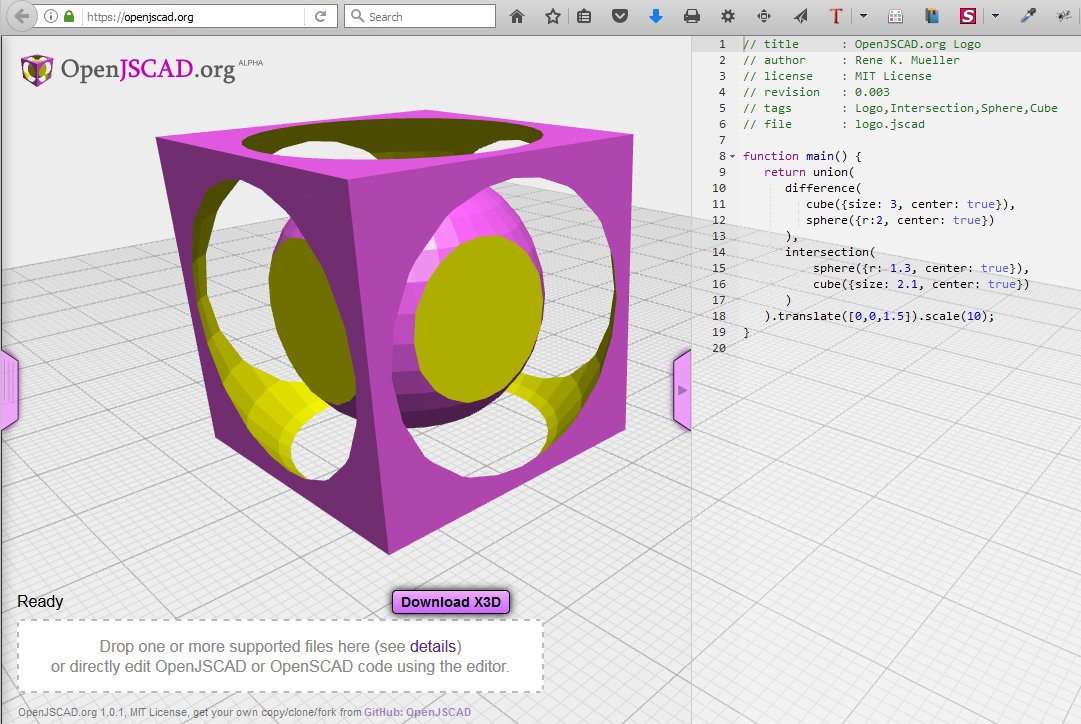


Translate () cylinder (r = 3, h = 4, Center = true) Many primitives then accept the “ center ” parameter, which draws the model centered on all axes: The other two most used solid primitives are sphere, whose only parameter is the radius, and cylinder, which can also draw trunks of cone, specifying the radii of the lower (r1) and upper (r2) bases. OpenSCAD works with absolute units, but its tools generally interpret them as millimeters, so our size 1 cube is really small to see it clearly we will have to zoom in the point of view: in the render window we can use the mouse wheel to zoom in and out, dragging and pressing the left mouse button will rotate the camera while pressing the right button, it will translate it.Īfter admiring our cube from all sides, let’s keep on learning the OpenSCAD geometric primitives.įirst of all, it must be said that the command “cube” actually draws rectangles: the three axes measures are referred to a vector, i.e. We render it by clicking on Design → Compile and our model will be displayed. If not visible yet, we ask OpenSCAD to show the x, y and z axes in the rendering window (View menu → Show Axes) then we can proceed to describe our first model.

Openscad tutorials software#
Launching OpenSCAD, we immediately notice that the interface is divided into three parts: the left is the source code area, on the right we have the rendered model area and the third is a section displaying the message log that greets us by showing the GPL license under which the software is released. In this first tutorial we’ll see the OpenSCAD basic functions, enough to create custom boxes for our projects. Thanks to all these characteristics, OpenSCAD is one of the most used software that can be found on various model file sharing websites (as Thingiverse). These features, together with its ease of use, make OpenSCAD a good choice for the hobbyist who wants to add to its electronic projects a structural or mechanical part, 3D printer with a 3Drag or made by using other numerical control tools. The other very visible OpenSCAD feature is that models are not created by mouse browsing but are described algorithmically in a simple programming language: this is one of the simplest user interfaces that allow you to achieve the accuracy required by CNC applications and also provides useful tools to make composed objects by mathematical formulas.
Openscad tutorials free#
OpenSCAD is a free software to create 3D models based on constructive solid geometry, it excels in modeling objects that require precision: from the simplest shape as a rectangular box up to complex structures or mechanisms. Depending on the targets you want to achieve, you have to pay attention to several modeling issues: in 3D models it is important the “external” and visual rendering, the surface properties, but when the model must be physically made, the real object structure and its mechanical properties are fundamental.įor this goal, the 3d modeling based on solids is a real help.

Another method worth mentioning is the constructive solid geometry (CSG) which describes the entire model volume starting from simple primitives such as cubes, cylinders, spheres and combining each other through unions, intersections and differences.Īs you can imagine, obtaining a realistic representation of organic forms with this system requires a lot of work vice-versa, it is a very suitable system for mechanical parts: in fact, these tend to be easily exploded into geometric primitives and are naturally represented by solid objects rather than by surfaces whose internal shapes are not defined. Talking about computer generated models and file formats, there are many ways: one of the most common, used by several popular software like Blender or Google Sketchup, is using polygon meshes to describe the model outer surface. The algorithmic methods are best suited both to achieve high model precision and to reproduce serially similar models. The “manual method” handbooks are inspired by the traditional plastic arts manuals, where you manipulate a material up to get it to the desired shape in algorithmic modeling, instead, you describe the object with programming techniques. A 3D model can also be obtained by scanning a real object.
Openscad tutorials manual#
There are two 3D modeling techniques: manual and algorithmic. With “3D modeling” we mean the design of a three-dimensional shape, the generation of the model and its representation in a digital format readable by a computer It is generally the first step needed in a wide variety of very different applications: for example, to fabricate physical objects with numerical control instruments or also for purely “virtual uses” as 3D computer graphic images or movie-making. Who prints 3D objects needs a 3D modeling and editing software to create and edit files a good example is OpenSCAD, that is also a nice resource to modify and process most of Thingiverse files.


 0 kommentar(er)
0 kommentar(er)
